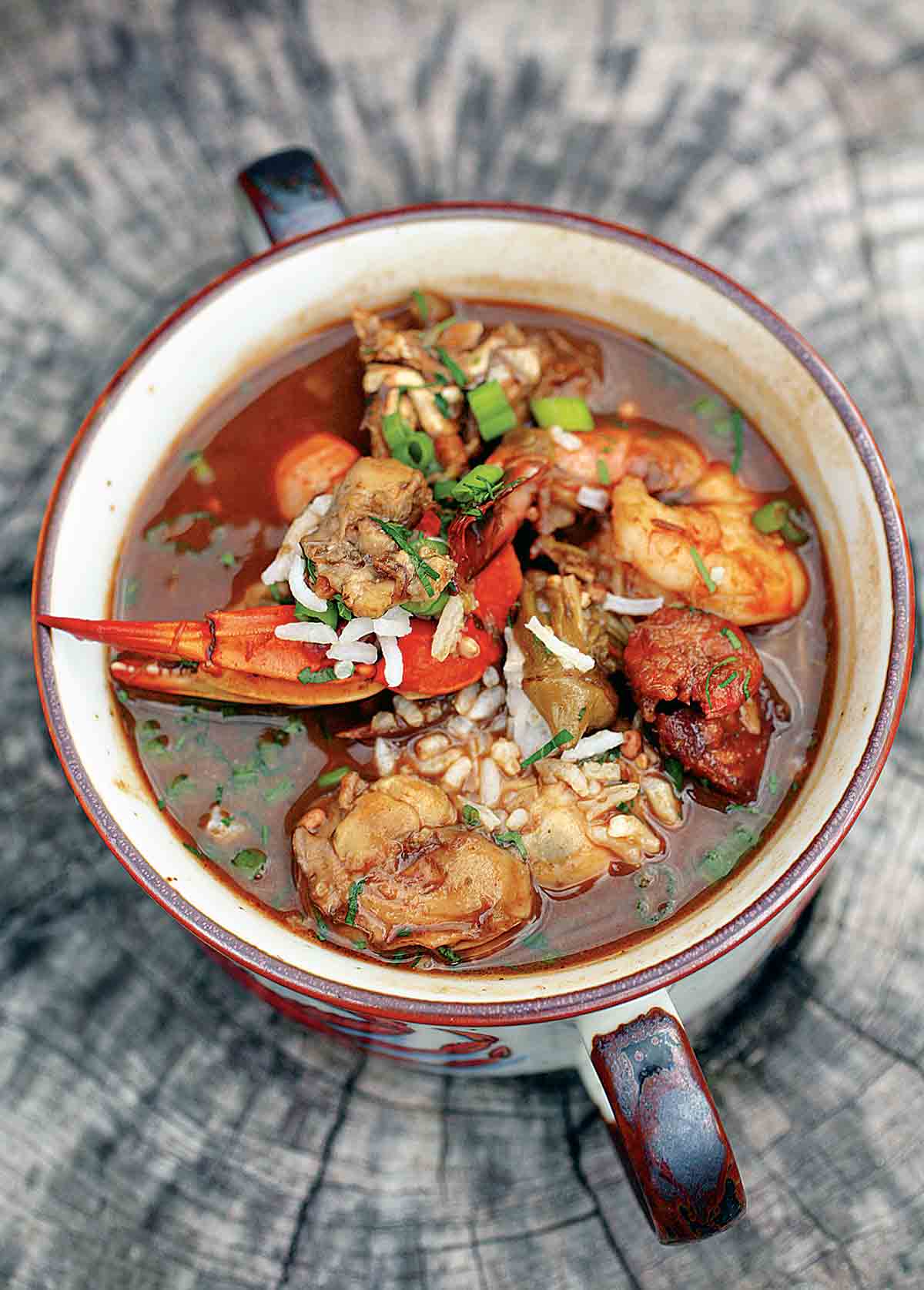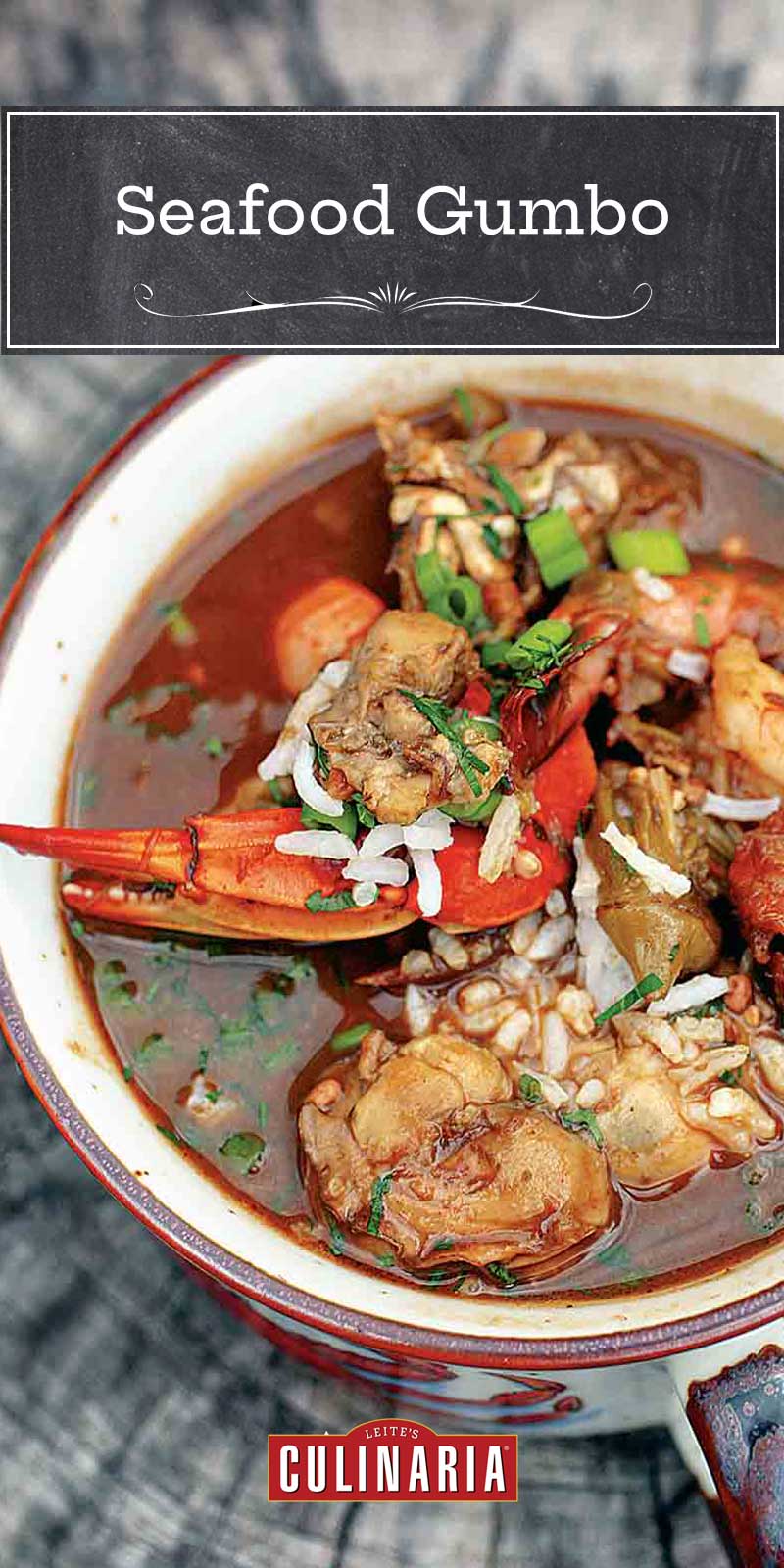
This seafood gumbo recipe was originally titled Super Bowl Seafood Gumbo, as the author makes this Cajun specialty each year for the occasion, just as his mother did before him. And we gotta say, we can understand why it’s a once-a-year-sorta recipe given that it takes the better part of a day to create the layers of flavors. That said, we can think of no better way to spend a weekend afternoon than standing at the stove conjuring this kind of culinary excellence. And, thankfully, it makes ample to share.–Renee Schettler
Seafood Gumbo FAQs
According to author and Cajun cook Donald Link, the process of making a roux for this seafood gumbo recipe can be hypnotic. It takes about an hour to put together a proper roux—and the process can’t be rushed. (That means no, you can’t stop stirring the pot or walk away from the stovetop.) Watching the oil and flour mixture slowly change color to robust darkness and begin to take on its unique aroma, says Link, gives you plenty of time to be alone with your thoughts (rather than obsessively checking Instagram to see how many folks liked your story alerting the world that you’re making a roux). He makes his roux with vegetable oil, not butter, to ensure that the neutral flavor can let the seafood take center stage.
Another hallmark of gumbo is the use of filé powder. If you’re not familiar with it, it’s made from dried sassafras leaves that works as both a seasoning and a thickener. Filé needs to be added near the end of cooking or it will form slimy, ropey strands in the gumbo. It’s available in many supermarkets or online.

Seafood Gumbo
Ingredients
For the seafood stock
- At least 6 cold beers for the cook, (kidding…sorta)
- 4 pounds medium (16 to 20 count) shrimp, shell-on and preferably head-on
- 6 blue crabs
- Salt
- 2 tablespoons vegetable oil
- 1 small onion, coarsely chopped
- 1 celery stalk, coarsely chopped
- 2 garlic cloves
- 2 teaspoons paprika
- One (4-inch) rosemary sprig or 2 tablespoons dried
- 13 bay leaves
- 9 quarts (36 cups) cold water
For the seafood gumbo
- 3 cups vegetable oil
- 4 cups all-purpose flour
- 1 large onion
- 2 medium green bell peppers, diced
- 3 celery stalks, diced
- 2 jalapeño peppers, stemmed, seeded, and finely chopped
- 6 garlic cloves, minced
- 2 tablespoons salt
- 2 teaspoons paprika
- 2 teaspoons filé powder
- 2 teaspoons store-bought or homemade chili powder
- 1 teaspoon freshly ground black pepper
- 1 teaspoon cayenne pepper
- 1 teaspoon white pepper
- 1 teaspoon dried oregano
- 2 teaspoons red pepper flakes
- 1 teaspoon dried thyme
- Several dashes of store-bought or homemade hot sauce
- 2 pints shucked oysters, liquor strained and reserved
- 1 pound crab claw meat, carefully picked over for shells
Instructions
Make the seafood stock
- Crack open a beer and start sipping while you peel the shrimp. Set the shells and heads aside in a bowl for the stock. Set the bodies aside for the gumbo. (Something to keep in mind for subsequent batches of gumbo is if you desire a richer stock, you can simply double the amount of shrimp shells. To amass this stash of shrimp shells, each time you peel some shrimp for a recipe, stash the shells in the freezer.)
- Bring a large pot of water to a boil. Add the crabs and a generous amount of salt, cover, and boil for 5 to 7 minutes. Drain immediately and set the crabs aside to cool. (Yes, after just 5 to 7 minutes. If you were going to fully cook the crabs, you would boil them for 10 to 15 minutes, but you want to leave most of the flavor in the crab so it imparts some to the gumbo.
- Peel the front flaps and tops off the crabs and place in a large bowl with the shrimp heads and shells. Use your fingers to scoop out the orange back fat from the middle of the crab and dump it in a small bowl. Break the crab bodies into 4 pieces each and set aside for the gumbo in a different bowl as the shrimp bodies.
- Heat the oil in a large pot over medium-high heat. Add the reserved crab and shrimp shells and shrimp heads, if using. Cook, stirring frequently, until the shells turn pink, 3 to 4 minutes. Add the onion, celery, garlic, paprika, rosemary, bay leaves, and 9 quarts cold water and bring to a boil. Reduce the heat and gently simmer for 1 hour.
- Remove the stock from the heat and strain, discarding the solids.
Make the seafood gumbo
- Heat the 3 cups vegetable oil in a large Dutch oven over medium-high heat. When the oil is hot but not smoking, whisk in the flour and reduce the heat to medium. Cook, whisking slowly but darn near constantly, until the roux has thickened and is the color of a dark copper penny, 45 minutes to an hour. You’ll want to reduce the heat gradually as you go. When the roux first begins to take on color, reduce the heat to medium. Continue in this fashion, gradually lowering the heat as the color of the roux deepens. By the end of the cooking, when the roux is appropriately dark, the heat should be on low. It’s essential to whisk the roux constantly as it cooks (but not so vigorously that you splatter the roux and burn yourself!), because if even a small bit of flour sticks to the pot, it will become spotty, scorch quickly, and impart a burnt taste to the entire roux.
- Carefully add the onion, bell pepper, celery, jalapeños, and the reserved crab back fat. (We say "carefully" because this will create a near volcanic reaction of bubbling, steaming, and sizzling. The roux at this point is around 400°F (204°C) and the addition of cold vegetables causes an explosion of flavors and smells.) Stir until the vegetables are well coated.
- Stir in the garlic, salt, paprika, filé powder, chili powder, black pepper, cayenne, white pepper, oregano, red pepper flakes, thyme, and hot sauce and continue to cook, stirring, for a few minutes.
- Add 2/3 of the strained stock and the oyster liquor, bring the mixture to a boil, then reduce the heat and simmer, stirring frequently and scraping the bottom of the pot to ensure nothing clumps and burns, until the mixture returns to a gentle simmer.
- If necessary, start skimming the oil from the top of the gumbo almost instantly (by the end of the cooking process, the gumbo will probably have released almost all of the oil from the roux). Continue to simmer and skim for about 1 hour. Taste it. If it still has a strong roux flavor, gradually add the remaining 1/3 of the stock, tasting as you go, until the flavor tastes more like the stock than the roux. If you don't use all the stock, freeze the remaining stock for another use.
- When the flavor of the gumbo has developed and its appearance is clearer (that is to say, with fewer dots of oil), add the oysters and crab meat. Bring the seafood gumbo back to a simmer and cook gently for 15 to 20 minutes. Skim once more and add the shrimp, and simmer for 1 more hour. Ladle the seafood gumbo into bowls and crack open another beer.

Nutrition
Nutrition information is automatically calculated, so should only be used as an approximation.
Recipe Testers’ Reviews
I thought this was a very good seafood gumbo recipe. Since I live on the West Coast, we get Dungeness crabs (known to all humans as the best crab anyway), so I used those instead of blue crabs. The gumbo had a nice depth of flavor and a nice amount of seafood, too. While I certainly tried to consume the 6 beers suggested in the recipe, I fell a bit short, but I don’t think the recipe lacked any flavor as a result.
I’ve never made seafood gumbo before—at least, not real gumbo. Wow. What an intense experience. It was very delicious and so balanced that, aside from a nice kick at the end of each spoonful, everything just melded together. Pure harmony.
But it’s very labor-intensive. That explains why it could be called Super Bowl Sunday Gumbo. The Super Bowl happens once a year, and that’s just about the limit of how many times I want to cook something for 6 hours—and I would consider myself a cook with the stamina of a marathon runner. The author was right about the 6 beers for the cook.












I’m gonna make this Christmas Eve for 40 people…any advice??
Hi Robbie, this is a great dish for a Christmas Eve dinner, providing you allow yourself enough time to cook the roux. Once the roux is done, you can add additional shrimp or other seafood and serve with rice (or my favorite, grits) to feed a crowd. Were you planning on doubling the recipe? If so, you will need a very large stockpot.
Robbie, I love that you’re making this for 40! And if you don’t have a single extraordinarily large stockpot, perhaps a couple large ones? Or maybe a local restaurant would loan you one?
We just tried this magnificent recipe in France. So we had to convert cups to grams and liters and maybe that’s why our roux was a bit abundant and our stock just enough. We added some okra too and the seafood gumbo was really thick. But it was delicious!
Next time we will make less roux but we’ll keep the okra and make more stock.
As there are no blue crabs in France, we took “tourteau” (a bigger brown crab) instead. And since we were 6, we cut the quantities in two and so we just bought a single tourteau. We also bought only a dozen of oysters and it was enough in our opinion.
The stock was super tasty! I decided to crush the heads of the shrimps to extract the very substance of their taste.
I wanted also to limit to the maximum the crab suffering, so I froze the tourteau for half an hour and then, with a huge knife and a hammer, I cut the creature in two. It was instant death and it helped me get the best parts of the crab easily and use the rest for the stock.
Anyhow, we had a marvelous time and we wanted to thank you for sharing this beautiful recipe.
Flor, you are so very welcome. Many kind thanks for taking the time to let us know that you, too, had a marvelous experience with the gumbo. Loved reading about your tweaks and your humaneness. Greatly appreciated.
Hi, I tried my best to make this and it was delicious, but mine was VERY thick, is it supposed to be like that? I had to add so much extra water just thin it down a little bit and it just seemed like enough to serve an entire party of 50+!!!!
Some other recipes called to add the roux to the stock to adjust the thickness. It browned well and I thought I did it exactly as the recipe called but by the end it was just gloop! Have you had that problem? Where did I go wrong?
Hi Katrina, you are right- this recipe can serve a crowd! I’m sorry that it turned out a little thick for you, how much seafood stock did you add?
I didn’t really measure the pot. Maybe next time I will try more stock…I was just so unsure because it seemed like so much already and there wasn’t any room for more water XD
Ah. I understand. Next time, perhaps grab a second large pot and divvy the contents between the two and then, if it thickens as it did this time, you can add more stock with room to spare.